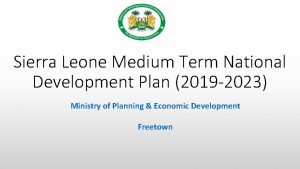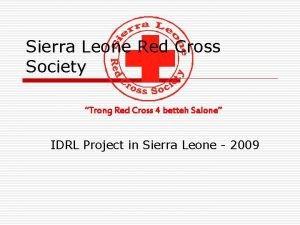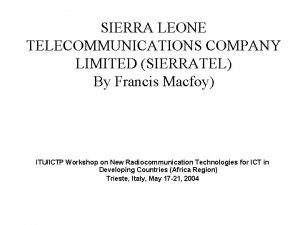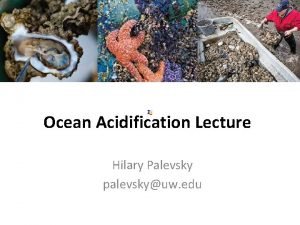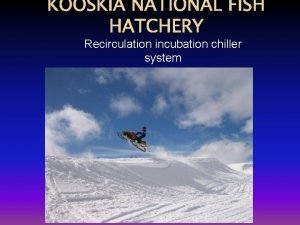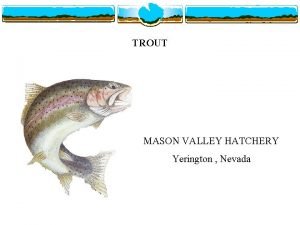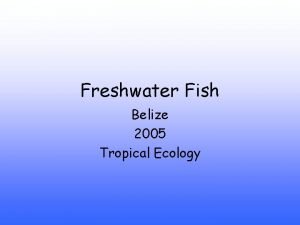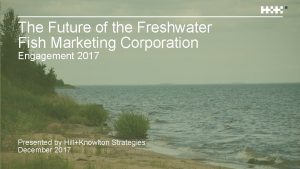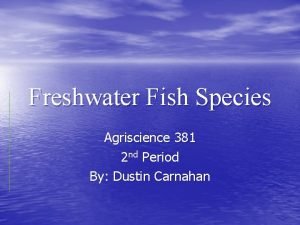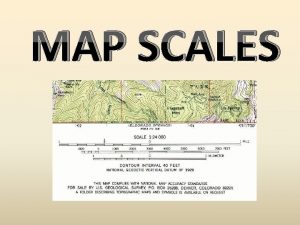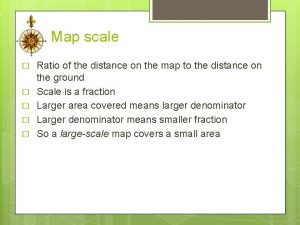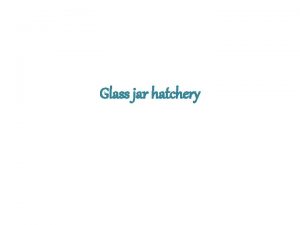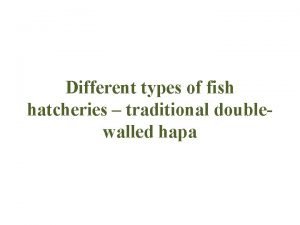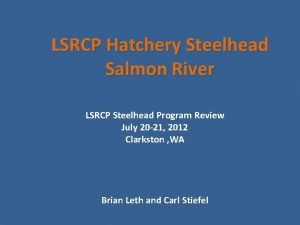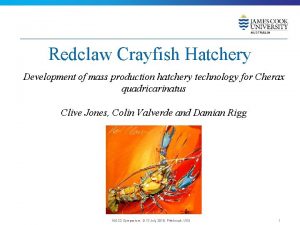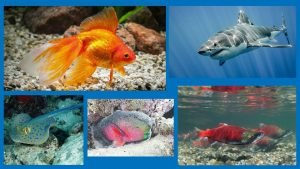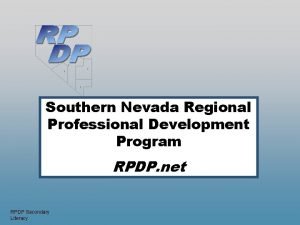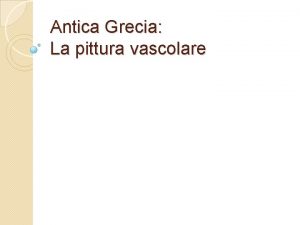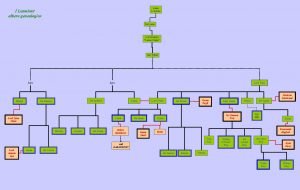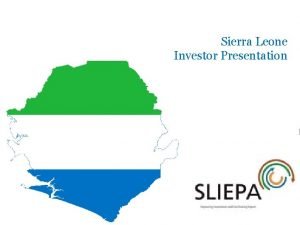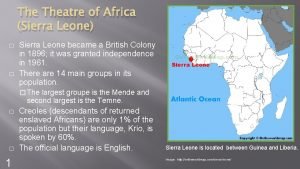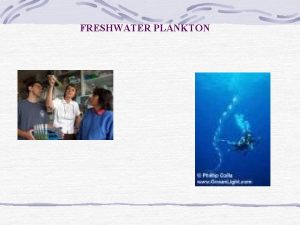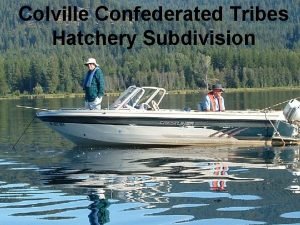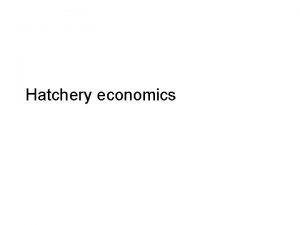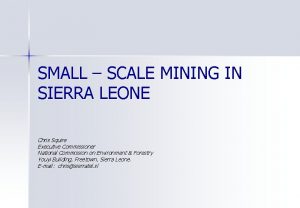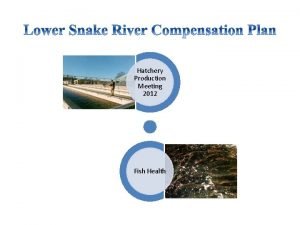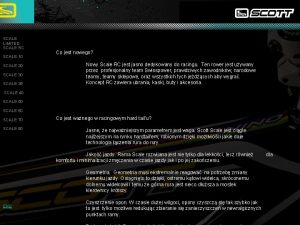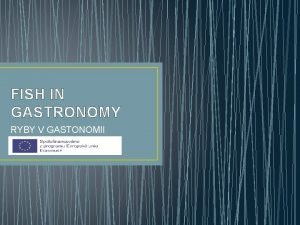SMALL SCALE FRESHWATER FISH HATCHERY IN SIERRA LEONE





































- Slides: 37

SMALL- SCALE FRESHWATER FISH HATCHERY IN SIERRA LEONE This project is the outcome of a group efforts to whom credit and technical responsibility goes. This project is based on an assignment which was given to course participants and supervised by Dr. Abdel Rahman El Gamal as a part of “Fish Culture Development Training course”. This annual course is organized by the Egyptian International Centre for Agriculture - Egypt (EICA). The Name and some photos of the team members are shown in subsequent slides 2006

CONTENTS • INTRODUCTION • OBJECTIVE • PROJECT IMPLEMENTATION • DISCUSSION & CONCLUSION

ORGANIZATION CHART CEO Mr. Ahmad Al Khrisat Jordan Management Manager Mr. Alfred Seasal (Sierra Leone) Operation Manager Mr. Adibi Rahiman (Malaysia) Development Manager Mr. Divity Venuc Popal (India) Fish Farm Manager Mr. Aung Zaw Win (Myanmar) Financial Manager Mr. Kaunding Krubally (Gambia) Hatchery Manager Mr. Sola Simmalavong (Laos) Marketing Manager Mr. Frederick Kajwara (Uganda)

JAWS COOPERATION

INTRODUCTION • Aquaculture in Sierra Leone – concentrated in Bo • Earthen pond - Species O. niloticus • Recent survey – 1050 ponds in the country (80% • • • private) Extensive & semi-intensive system Total aquaculture production 40 tonnes/year Nowadays the farmers just collected the fingerlings from the natural and nurse it in the ponds before sold to other farmer

INTRODUCTION (Cont. ) • There was an existing hatchery but not operate anymore due to the war 10 years ago • The hatchery belong to the government • The area is 2 ha with basic facilities such as some ponds, building, access road, electricity etc. • The government will renovate this hatchery according to our operation

OBJECTIVES • To improve existing hatchery • To fulfill the market demand • To develop small scale freshwater hatchery • To provide employment for the people in that area Our target production is one million of fingerlings every year

PROJECT IMPLEMENTATION • Invited by the government of Sierra Leone to introduce a small scale tilapia hatchery • The project will be done in a 5 years by our company and then will be given back to the government

HUMAN RESOURCES • The work force of the project consists of : • 1 farm supervisor (government staff) • 3 general workers (the government will select)criteria: poor people • Our company will do the management & marketing

SITE SELECTION • Sewa River, Bo, Free Town, Sierra Leone • Source of water : river – fulfill the water quality parameters • Support from the government

Site of the project

Species Selection-Oreochromis niloticus • This species enjoys high people demand • Tilapia culture requires minimal management efforts and • • hence could be farmed in low-tech systems The reproduction of the species is easy Tilapia enjoys good farming characteristics such as: – High growth rate – Readily domesticated “aquatic chicken” – Hardy and tolerant to disease as well as to wide range of environmental conditions

Hatchery Operation - Hapa • An intensive method for producing tilapia fry as required for grow out purposes • May use an inverted mosquito net - made of polyethylene netting designed to facilitate holding, breeding & nursery of products • We decided to use hapa system in our project

Advantages of hapa system • Ease in moving & relocation • Easy to control competitors & predators • Ease in daily observation of stocks & allows better management • Handling of live fish is greatly facilitated • Maximizes the utilization of available water resources, hence reduces the pressure on land resources. • All spawning products are collected • Fry produced are more uniform in size

Disadvantages of hapa system • Management is more intense • High labor cost for handling, stocking and maintenance • vulnerable to poaching • Easily destroyed and blown away by typhoons or storms • Securing an adequate water exchange through the hapas and cages all-time is a must

System Design & productivity • • • Size of spawning hapa: 3 m x 1. 5 m depth Density of broodstock 4 fish/m 2 Sex ratio 1 Male : 3 Female Number of broodstock: 36 (27 F & 9 M) Production out of each hapa: 5103 fingerlings Productivity estimate is based on the following assumptions

Assumptions • • • Fecundity No. of broodstock Males Females Total no of fry Total no of fingerlings (6 cycles) SR = survival rate - 300 eggs/female/spawn 1440 (40 hapas) 360 (~300 g) 1080 (~250 g) 291600/cycle (90% SR) 1. 22 million (70% SR)

BREEDING CYCLE OF O. niloticus NEST BULDING & COURTSHIP (1 -5 DAYS) Development of ovary after incubation FEEDING & RECOVERY (10 -30 DAYS) OVULATION & SPAWNING (< 2 HOURS) Maternal dependency NURSERY (10 -30 DAYS) INCUBATION (6 -10 DAYS) Continued maternal dependency; fry & mother begin to feed Holding of seed in mouth continuously

PRODUCTION METHODS

Egg Collection Timing of egg collection depends on: Water temperature Maturity condition of females Eggs will be collected from female’s mouth 7 days after stocking

Methodology - Egg Collection • Carefully lift the 3 bottom corners of the hapa • Remove each female broodfish one at a time • Carefully check female’s mouth for incubating eggs • Remove the eggs & yolk sacs by washing from female’s mouth • Eggs are placed in 4 bowls according to their colors

Sorting collected products according to colors = same embryonic development Collected eggs/products are sorted into: Yellow (just spawned) Dark yellow/orange Pigmented/eyed Yolk sacs/swim-ups Eggs may be treated with formalin (treatment); salt (5 -7 ppt) may be used Any swim-up fry found will be scooped out

Methodology- Fry Collection Fry collection This applies to the collection of free-swimming stage Collection takes place after 11 to 14 days after the stocking of broodfish Labor & equipment 2 to 3 field workers for collecting eggs/fry 2 field workers to do stocking for conditioning 1 field staff for cleaning/ disinfecting collected eggs before incubation 1 technician to record data Basins, tubs, scoops, weighing scale

Methodology – Incubation/Pipping System Gravity & continues water flow is secured 1. 5 liters -3 liters

Incubation

Hatching

INCUBATOR SET LAYOUT Water Filter Over head tank – 2 tones ( Recycle water ) Inlet water filter Nursing Tanks Water Treatment System Nursing Tanks Incubator Jar

Ponds and tanks Breeding ponds • Two ponds of 0. 1 -ha each • 40 hapas Nursing tanks • Function: to nurse hatched fry before transferred to nursing pond • 18 concrete tanks of 6 m x 3 m x 1 m depth • Placed in the same location with incubator set

Ponds and tanks Nursing ponds • 1 pond of 0. 1 ha with 20 hapas is required for nursing 100 000 fingerlings • A hapa of size 3 m x 1. 5 m is needed for 5000 fingerlings • For the production of one million 5 ponds (0. 5 ha total area) and 100 hapas will be needed Conditioning pond • 1500 brood stocks (total) • Density 3 fish/m 2 • Three 0. 1 -ha ponds are needed for males, females and back-up • A hapa with size of (2 m x 5 m) will be needed for 30 fish – For males: 15 hapas – For female: 40 hapas

Broodfish replacement & rotation strategy Broodfish that spawned will be reconditioned: – This will lead to higher spawning success – During reconditioning, broodstock will be separate by sex – Good quality feed will be provided (on-farm formulated or commercial)

1 Incubator set HATCHERY LAYOUT 2 Office 3 Store 4 Watchman Shed Inlet Secondary canal Main canal Nursing pond Conditionig pond Conditioning pond 4 Outlet Reservoir pond Drainage canal Breeding pond Nursing pond Nursing pond Secondary canal Inlet 3 2 1 Nursing pond

ANNUAL ACTIVITIES CHART YEAR : 2007 FARM ESTABLISHMENT MONTH ANNUAL ACTIVITIES CHART 1 2 3 4 5 6 7 8 9 10 11 12 1. SURVEY 2. VISIBILITY 3. SITE SELECTION 4. PERMISSION FOR ESTABLISHMENT OF FARM 5. FUNDS MOBILIZATION 6. FISH HATCHERY CONSTRUCTION ACTIVITIES YEAR : 2008 FARM ACTIVITIES MONTH 1 2 3 4 5 6 7 8 9 10 11 12 1. POND PREPARATION 2. BROODSTOCK COLLECTION 3. WATER QUALITY ANALYSIS 4. BREEDING PROGRAMME 5. HATCHERY MANAGEMENT 6. WATER MANAGEMENT 7. HARVESTING ANNUAL ACTIVITIES CHART ACTIVITIES

Capital Development Cost Item Cost (USD) Land (2 ha) 3000 Aeration 3000 Land clearing 200 Generator 500 Farm road 500 Hapas 2000 Pond construction 15000 Water pump 1000 Water system 3000 Lorry 3000 Electricity system 2500 Incubator set 1000 Office Building 5000 Concrete tank 2000 Storage & worker’s quarter 5000 Contingencies 2335 TOTAL 49035

Operation cost Item Cost (USD) Fertilizers 1000 Chemicals 300 Lime 500 Oxygen 300 Broodstock 1000 Salary Feed 12000 Administrative expenses 500 15600 Electricity 500 Maintenance 2452 Petrol/diesel 500 Contingency 986 TOTAL 35638

Project revenue & financial analysis Project revenue Financial analysis 1 000 fingerlings Net income – USD 14362 Sale price for 1 fingerling – USD 0. 05 IRR – 26% Total Revenue – USD 50000 Cost of production – USD 0. 04/a fingerling Payback period – 4 to 5 years

DISCUSSION & Conclusion • This project is very important in regard to increasing aquaculture production in Sierra Leone especially fish is the main protein source • A million of fingerlings can produce 400 tons of fish which equals 10 folds of the present aquaculture production in Sierra Leone • This project has great potential as an economic activity and serve as a model of small scale aquaculture for enhancing household incomes and promoting rural employment

Thank You Shukran Gracias Merci
 One fish two fish red fish blue fish ride
One fish two fish red fish blue fish ride Medium term national development plan
Medium term national development plan Sierra leone
Sierra leone Who is dr tamba in a long way gone
Who is dr tamba in a long way gone Sierra leone telecommunications company
Sierra leone telecommunications company Irrigon fish hatchery
Irrigon fish hatchery Hilary palevsky
Hilary palevsky Kooskia national fish hatchery
Kooskia national fish hatchery High valley hatchery
High valley hatchery One fish two fish blowfish blue fish script
One fish two fish blowfish blue fish script Characteristics of actinopterygii
Characteristics of actinopterygii A big fish swims up and swallows a small fish at rest
A big fish swims up and swallows a small fish at rest Saber toothed anchovy biome
Saber toothed anchovy biome Saltwater fish in freshwater explode
Saltwater fish in freshwater explode Hill + knowlton
Hill + knowlton Texas freshwater fish identification
Texas freshwater fish identification Texas freshwater fish species
Texas freshwater fish species Small vs large scale maps
Small vs large scale maps Large scale vs small scale map
Large scale vs small scale map Nominal scale map
Nominal scale map Large scale map
Large scale map Large scale vs small scale map
Large scale vs small scale map Glass jar hatchery
Glass jar hatchery Difference between breeding hapa and hatching hapa
Difference between breeding hapa and hatching hapa What to serve with salmon
What to serve with salmon Crayfish hatchery
Crayfish hatchery Lyons ferry hatchery
Lyons ferry hatchery California hatchery reviews
California hatchery reviews Male fish reproductive system
Male fish reproductive system Spiracles in fish
Spiracles in fish Whole fish market form
Whole fish market form Figure retoriche analogia
Figure retoriche analogia Father of forensic toxicology
Father of forensic toxicology Jill leone
Jill leone Leone lattes contribution to forensic science
Leone lattes contribution to forensic science Hocum
Hocum Pittura antica grecia
Pittura antica grecia Albero genealogico lannister
Albero genealogico lannister

